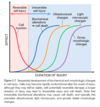Lecture 1: Cellular Responses to Stress and Toxic Insults: Adaption, Injury, and Disease Flashcards
Based on Robbins Outlines (176 cards)
FLeakage of intracellular enzymes (i.e., lactate dehydrogenase) is a marker of?
Irreversible cell injury
What kind of cellular adaptation is a result of increased demand and stimulation?
Hyperplasia or hypertrophy
What kind of cellular adaptation is a result of chronic irritation (physical or chemical)?
Is it irreversible or reversible?
Metaplasia
Reversible
What cellular adaptation is most common in the uterus during pregnancy; stimulated by?
Endometrium from estrogen?
- Hypertrophy during pregnancy; stimulated by estrogenic hormones
- Hyperplasia (pathologic) of endometrium from estogen, but still remains as a thin lining to the muscular wall and does not contribute as much to the change in size!
What cellular adaptation is most common in muscle disuse?
Barrett esophagus?
- Muscle disuse = atrophy
- Barrett esophagus = goblet cell Metaplasia (squamous to columnar type)
Metabolic alterations to a cell that are due to chronic injury result in what?
Intracellular accumulations, calcification
The most common stimulus for hypertrophy of skeletal muscle is __________
Increased work load
The most common stimulus of hypertrophy for cardiac muscle is ________.
Usually resulting from what?
- Increased hemodynamic load
- HTN or faulty valves
What is the key characteristic of hypertrophy?
Increased protein synthesis
During the increased workload on the heart growth factors are stimulated and 2 biochemical pathways activated, which is thought to be the most important in physiologic muscle hypertrophy and which in pathologic hypertrophy?
- PI3K/AKT in physiologic (i.e., exercise induced) hypertrophy
- Signaling downstream GPCR’s in pathologic hypertrophy
Cumulative sub lethal injury over long life span induce what cellular response?
Cellular aging
Which TF’s are activated in the molecular pathogenesis of cardiac hypertrophy and work to increase the synthesis of muscle proteins responsible for hypertrophy?
GATA4, NFAT, and MEF2
*NFAT, GATA4, and MEF2 inhibitors are in phase 1 or 2 clinical trials; hoping to prevent cardiac failure from excessive hypertrophy
What 2 adaptions does cardiac hypertrophy elicit that are associated with fetal heart functions?
What is the purpose of these adaptions?
1) Switch of contractile proteins from adult myosin heavy chain α isoform to the fetal/neonatal β isoform
- The β isoform has a slower, more energetically economical contraction
2) Increased expression of ANP (atrial natriuretic factor), which is down-regulated after birth
- Kidneys secrete Na , water follows, reduces blood volume
What type of necrosis is associated with tuberculous infection?
What type specifically?
- Caseous necrosis
- Myobacterium tuberculosis
*Caseous necrosis is described as what?
How does it look on microscopic examination?
- Yellow-white and “cheese-like”
- Structureless collection of fragmented or lysed cells and amorphous granular debris enclosed within a distinctive inflammatory border (Granuloma)
The female breast is an example of what 2 cellular growth adaptions?
- Hormonal hyperplasia: proliferation of glandular epithelium at puberty
- Hypertrophy: during pregnancy
What are 2 examples of compensatory hyperplasia (liver and bone marrow)?
- Donating a lobe of liver for transplantation, remaining cells proliferate so that organ grows back to original size
- After acute bleed or hemolysis, there is great expanse of red cell progenitors due to EPO
What are the causative agents involved in pathologic hyperplasia of the endometrium and in benign prostatic hyperplasia; can these abnormalities be fixed?
- Endometrial hyperplasia = estrogen
- BPH = androgens
- Can be treated by simply fixing the hormonal imbalances, allowing them to revert back to normal
How is hyperplasia related to cancer?
- Hyperplasia itself is NOT cancer
- Pathologic hyperplasia constitutes a “fertile soil” in which cancerous proliferations may eventually arise
What is the characteristic signs of atrophy?
Autophagy and decreased protein synthesis
In cancer, what is responsible for the suppression of appetite and depletion of lipid stores that culminates in muscle atrophy?
TNF
The degradation of cellular proteins seen in atrophy occurs mainly through which pathway?
- Ubiquitin-proteasome pathway
- Nutrient deficiency and disuse may activate ubiquitin ligases, which attach the small peptide ubiquitin to cellular proteins and target these proteins for degradation in proteosomes
What is one of the hallmarks of atrophy and how can this be visualized?
- Autophagy: starved cell eats its own components in an attempt to reduce nutrient demand to match supply
- Some cell debris may resist digestion and persist in cytoplasm as residual bodies
- Example of residual bodies is lipofuscin granules, which can impart a brown discoloration to the tissue
What is the most common epithelial metaplasia and what are some examples?
- Columnar to squamous (squamous metaplasia)
- Respiratory tract in response to chronic irritation; in smoker the normal ciliated columnar of the trachea and bronchi are replaced by stratified squamous cells
- Stones in the excretory ducts of salivary glands, pancreas, or bile ducts, may also lead to squamous metaplasia





